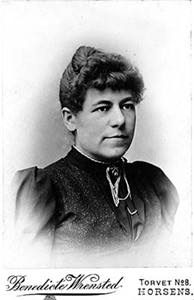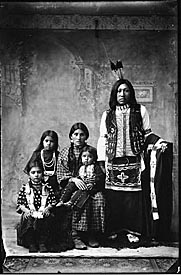Benedicte Wrensted:
An Idaho Photographer in Focus

Credit: Scherer Personal Collection.
The remarkable photography of Benedicte Wrensted (1859-1949) lay in obscurity for decades until brought to light by the detective work of Smithsonian anthropologist Joanna Cohan Scherer. In 1984, while researching photographs for the Smithsonian's Handbook of North American Indians, Scherer found a collection of glass plate negatives at the National Archives and Records Administration (NARA) in Washington, DC. Labeled only as "Portraits of Indians from Southeastern Idaho Reservations, 1897," the images were so compelling that Scherer had prints made for the Handbook - a 20 volume encyclopedia summarizing the anthropology and history of Indians and Eskimos of North America north of Mesoamerica. Fifteen volumes of the Handbook were published before the project was terminated in 2007.

Credit: * National Archives and Records Administration, Still Picture Branch: 75-SEI-93
In the mid-1980s, Scherer found some of the photographs in the collections of the Bannock County Historical Society. These were in their original cardboard mounts, which bore the name of the photographer, Benedicte Wrensted. Scherer then began a ten-year investigation of the life of this photographer - from her birth in Denmark to her photographic career in Pocatello, Idaho - and to identify many of her subjects.
The 148 glass plate negatives housed in the NARA since the 1930s were unattributed and unidentified but had nevertheless been widely reproduced. We know today that they are the work of Benedicte Wrensted, taken between 1895 and 1912. An additional 148 glass negatives housed since the 1940s in the Idaho Museum of Natural History, Pocatello were also unattributed. A number of these were taken by Benedicte Wrensted as well.
In 1993 an exhibition was created using some of these photos. Only 1% of the Wrensted images at the NARA were identified at the onset of the project. Once they were shown to the descendants at the Fort Hall Indian Reservation, the families of origin were discovered. Individual names were recovered from written records, and today 84% of Wrensted subjects have been identified.
Many of the photographs in this exhibit were modern enlargements from copy negatives made from the best possible prints, which were in turn made from the original dry-plate glass negatives. A few of the reproductions were made from vintage prints. Enlargements made directly from original glass negatives are indicated by an asterisk (*).
This exhibition was supported by:
- Idaho Humanities Council
- Idaho Museum of Natural History
- Smithsonian Institution Special Exhibits Fund
- Smithsonian Institution, Natural History Rotunda Fund
- The CHC Foundation
- Bannock County Historical Society and Museum
- Smithsonian Institution Suzanne Liebers Ericksen Danish Exchange Program
- Joanna Cohan Scherer, Curator
- Anne Merkley, Assistant Curator
- Don Szymansky, Exhibit Design
- Bonnie C. W. Wadsworth, Consultant
Exhibit produced in 1993 by Idaho Museum of Natural History and traveled throughout Idaho and then nationally through 1998.
Web page designed by BillieSue Sawyer, Smith College (1996) and Emily Solomon, The George Washington University (2017).
This web site was constructed with the assistance and support of:
- Gayle Yiotis, Smithsonian Institution, NMNH Repatriation Office
- Smithsonian Institution, Information Technology Office, NMNH
- Carl C. Hansen, Branch Chief, Smithsonian Institution, NMNH Office of Imaging, Printing and Photo Services
This web site was redesigned in 2017 by:
Jim Kochert
Smithsonian Institution,
National Museum of Natural History,
Information Technology Office,
Web Branch
[ TOP ]